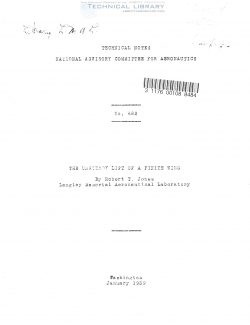naca-tn-682
- Version
- 149 Downloads
- 1.26 MB File Size
- 1 File Count
- November 28, 2016 Create Date
- November 28, 2016 Last Updated
National Advisory Committee for Aeronautics, Technical Notes - The Unsteady Lift of a Finite Wing

Unsteady lift functions for Wings of finite aspect
ratio have been calculated by approximate methods involv—
ing corrections of the aerodynamic inertia and of the an—
gle of the infinite wing.
The starting lift of the finite Wing is found to be
only slightly less than that of the infinite Wing; Whereas
the final lift may be considerably less. The calculations
indicate that the distribution of lift near the start is
similar to the final distribution.
Both the indicial and the oscillating lift functions
are given. Approximate ope-ational equivalents of the
functions have been devised to facilitate the calculation
of lift under various conditions of motion,
The two—dimensional potential theory of airfoils in
unsteady motiOn was set forth by Wagner (reference 1) and
has been extended to problems involving the motion of
hinged or flexible airfoils by Theodorsen (reference 2)
and Kussner (reference 8).
It is known that, in the case of steady motion, a
correction is necessary before the results of the twondi—
menSional theory can be applied to actual wings of finite
aspect ratio. No corresponding correction has, hoWever,
been developed for the conditions of nonuniform motion.*
The calculations contained herein lead to such a correc-
tion, which is applicable, within the usual limitations,
to arbitrary dynamical conditions of motion.
Owing to the presence of circulation, the lifting
Wing leaves in its wake a surface of discontinuity whose
local vortex strength Will be determined by the rate of
change of circulation taken both across the span and along
the flight path. (Sec fig. 1.) The formation of such a
wake and the configuration of the vortices in the wake are
determined by the assumption that the flow at each instant
conforms to the Kutta condition. An essential feature of
the problem is the determination of the influence of this
wake on the wing.
| File | Action |
|---|---|
| naca-tn-682 The Unsteady Lift of a Finite Wing.pdf | Download |
Comment On This Post